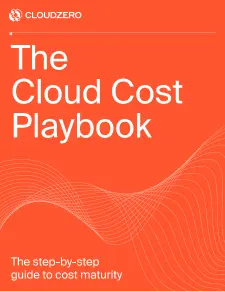Welcome to CloudZero’s inaugural Cloud Economics Pulse! This is our monthly snapshot of how cloud spend is evolving across providers, services, and emerging AI workloads.
Each month, we’ll surface key trends, highlight where the money’s moving in cloud spend, and offer practical insight to help FinOps and cloud cost teams stay on top of things.
October — and preceding months — shows a turbulent stretch for cloud economics. Spending patterns shifted; AI and data-heavy workloads took a larger share of total costs, while compute’s share edged down. We saw some MoM shifts in the Big Three cloud share (AWS, GCP, Azure), and the worst-kept secret in the cloud environment is showing itself in numbers: AI costs are markedly rising.
In this month’s deep dive, we look at why that’s happening, and what FinOps teams can do right now to bring control and clarity to this new era of cloud spending.
How We’re Looking At Data (And Why It Matters)
For the Cloud Economics Pulse, we track monthly cloud spend trends using anonymized, aggregated data from CloudZero’s network.
- Cost by Provider and Cost by Service Category are shown as stacked charts, each illustrating how providers and service types contribute to total cloud spend over time.
- Cost of AI/ML measures the share of AI and machine learning technologies as a percentage of all cloud spend and is presented as a line chart to highlight trends.
Together, these views show not just where cloud dollars go, but how spending patterns shift as new technologies — especially AI — reshape the cost landscape.
Main Highlights For October 2025
- AI spend cools slightly. After months of rapid growth, AI and ML costs dipped to 5.1% of total spend as teams adjusted workloads and usage patterns.
- AWS widens its lead. AWS stays above 69% of total provider spend, while Azure and GCP held steady or slipped.
- Cloud mix keeps shifting. Compute still dominates, but AI and data services now drive most of the year’s growth in cloud spend.
1. Cost By Provider
Here, we’re looking at how overall cloud spend is distributed across providers:
Cloud provider spend continues to see shifts in 2025 as organizations rebalance workloads across hyperscalers and new AI vendors. AWS continues to dominate the cloud landscape, climbing from 67.8% of total spend in January to 69.2% by October with gains throughout the year.
We also see growth in AI and ML workloads (more on this below) and a rise in AWS Marketplace purchases (from 1.7% in January to 3.9% in October). That’s a sign that enterprises are consolidating more of their spend inside the overall AWS ecosystem.
Azure, by contrast, trended downward, slipping from 12.5% in January to 11.5% by October, its lowest share in more than a year. That gradual decline likely reflects AI workload migrations toward AWS and specialized providers offering stronger cost-to-performance ratios for training and inference. GCP has fluctuated between 5.8% and 6.5%, without significant rise or fall in spend.
The most interesting shift lies outside the Big Three: AI-centric vendors like OpenAI, Anthropic, and Databricks starting to make their case as a percentage of overall spend — although tagging AI spend is an emergent science. Still, early signs point to the rise of a “Big Three plus AI layer” in enterprise cloud portfolios.
Key Takeaways
- AWS strengthens lead: Up ~1.5 points from January.
- Azure softens: Down about 1 point during same period.
- GCP steady: Flat near 6%.
- AI vendors emerging: Still small but forming a new cost layer beyond hyperscalers.
2. Cost By Service Category
Here, we’re looking at how overall spend is distributed across cloud services:
Cloud service mix continues to evolve in 2025 as organizations rebalance workloads between core compute and emerging AI services. Compute — driven heavily by Amazon EC2 and newer chip families like Graviton and Trainium — remains the dominant category, accounting for roughly 49.1% of all spend, though its share has edged down slightly from earlier.
That dip in Compute isn’t from reduced compute use; far from it, actually. Rather, it reflects the introduction and growth of new service layers, especially AI and machine learning (again, more on that below).
Meanwhile, Database costs came in at 10.9% of total spend in October, representing a slow descent from 12.6% in January. It dropped below 12% in May, and then below 11% in July. It hasn’t come up since.
Storage spend stayed consistent between 9.3% and 9.4% of total spend, but rose to 10.2% in September and 10% in October. This suggests improved tiering and compression are successfully offsetting data growth.
Finally, the broad “Other” category — which includes container orchestration, management, and platform services — has trended downward since midyear, dropping from 18.1% in April to 14.5% in October as teams clean up unused or overlapping resources.
Key Takeaways
- Compute still dominant: Roughly half of all cloud spend, but trending slightly down.
- Data services steady: Databases and storage remain resilient, representing a full fifth of all spend.
- Platform trim-down: “Other” services drop a few points as teams optimize usage.
3. Cost Of AI/ML
Finally, let’s look at AI and Machine Learning and how much it takes up the cloud cost ecosystem, this one from January 2024 onwards:
AI and machine learning costs surged through 2025. That’s obviously known; worldwide spending on AI is estimated to total $1.5 trillion in 2025 according to a Gartner report from September. That’s up from just under one trillion in 2024 — a meteoric rise.
When we view AI/ML as a simple average share of total cloud spend, AI/ML costs jumped from 2.2% in January to a peak of 6.5% in September, before settling near 5% by October. Plus, that’s roughly triple 2024 levels (1.34% average) in our network data, showing how AI workloads now account for a meaningful slice of overall cloud budgets.
However, averages can hide extremes. Large enterprises with massive GPU clusters heavily influence total spend, inflating the perception of how pervasive AI costs are across the board. To get a clearer picture of what’s typical, we also track the median AI/ML share — essentially the midpoint across all organizations, where half spend more and half spend less:
By that measure, AI/ML spend grew from just 0.13% of total costs in early 2024 to nearly 0.5% by October 2025. That’s a smaller number, but shows an even more striking trend — a nearly fourfold increase in the “middle of the market.”
This median view reveals that AI adoption isn’t just a large-enterprise phenomenon anymore. It’s spreading steadily across companies of all sizes, with more teams running inference workloads, fine-tuning smaller models, or integrating AI APIs into systems and features.
In short, the average view shows total market growth, driven by high-spending leaders, while the median view shows democratization — the point where AI spend is becoming a normal line item for most organizations, not just early adopters.
Key Takeaways
- Overall AI/ML spend shooting up: Average % rose from 2.2% in January to a 6.5% September peak, and median AI/ML also skyrocketed showing mainstream adoption.
- Signs of tectonic movement: 2025 marks the point when AI spend shifted from experimental to operational — no longer just a big-tech budget item, but a standard cloud cost category.
Deep Dive — Why AI Costs Are Mounting
AI costs are rising faster than any other cloud category, driven less by new demand and more by inefficiency. Average AI workloads can cost multiple times more per hour than standard compute, and even then, GPU instances will remain idle 40% of the time in an example shared by the FinOps Foundation — meaning teams are paying for capacity they aren’t even using.
Meanwhile, larger training datasets push up database and storage costs in AI-heavy environments.
Main culprits to look for are:
- Overprovisioned GPUs held “just in case” capacity is needed.
- Unoptimized ML pipelines that waste compute and duplicate data.
- Limited use of preemptible or spot instances for non-critical training.
In short: AI costs keep climbing not because usage is skyrocketing, but because governance and efficiency haven’t caught up.
Actionable Guidance
If your AI costs are climbing faster than planned, it’s time to bring FinOps discipline to model operations. Start with visibility — because you can’t manage what you can’t see.
Ensure your allocations are as granular and accurate as possible.
Then, reframe AI/ML spend as value for cost rather than as an outright expense. CloudZero CTO Erik Peterson puts it explicitly: “Stop asking what AI costs. Ask if it’s worth it.”
Finally, focus on efficiency at every stage of the pipeline.
- Adjust GPU workloads. Profile training and inference jobs to understand true compute needs, then match instance types and durations accordingly.
- Automate idle shutdowns. Even an hour or two of idle GPU time per day can add up. Schedule pauses for non-critical jobs.
- Tier and compress training data. Archive or downsample datasets not used in active cycles to control storage growth.
- Use preemptible or spot instances. Non-critical or batch training jobs often tolerate interruptions — these savings can be substantial.
- Benchmark AI costs per product or team. Build internal transparency around who’s driving spend and how efficiently they’re running workloads.
Bottom line: Treat AI as its own cost domain, not just another compute category. Visibility, utilization, and accountability will separate teams that manage AI costs strategically from those that get blindsided. Our AI Cost Optimization Playbook will come in handy here.
Your Takeaway For This Month
AI is reshaping the cloud bill. Averages show the total market tilting toward AI spend, while medians tell us adoption is widening across the middle of the pack. Compute still anchors the stack, but governance hasn’t kept pace with model operations — that’s why costs are outrunning value.
Add growing marketplace spend and a slow drift toward AWS, and you have a clear mandate: treat AI as its own cost domain, with real accountability and tight guardrails.
In short: the winners will pair velocity with visibility — adjust GPU footprints, track cost per product or team, and design pipelines with cost in mind from the start.
Thoughts, comments, disagreements? Reply to this Pulse or email [email protected] with “Pulse” in the subject heading. We’ll feature the best comments in an upcoming issue. Watch for our next Cloud Economics Pulse on December 9.








